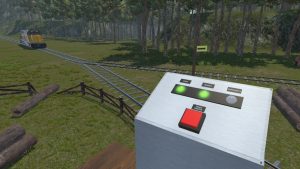Experiments in Virtual Philosophy (guest post by Erick Ramirez)
The following is a guest post* by Erick Ramirez, assistant professor of philosophy at Santa Clara University. Among other things, Professor Ramirez has been working on philosophical issues related to the limits of our capacities for empathy and taking the perspective of others, and he has been developing exciting new tools to help us somewhat overcome these limits in our philosophical investigations.
Moving Beyond the Thought Experiment Paradigm: Experiments in Virtual Philosophy
by Erick Ramirez
Thought experiments are a deep part of philosophical methodology. In the classroom, we use thought experiments to help students better understand complex (usually moral) arguments or to try and get students to actively engage as moral agents. In our research, thought experiments often serve as arguments in and of themselves.
We might ask our readers to ‘suppose that they were kidnapped by the Society of Music Lovers’ or to ‘imagine they find themselves at the switch and a runaway trolley car is headed their way.’ If we’re especially ambitious, we might ask readers to ‘imagine that a terrorist has hidden a bomb somewhere in Paris.’ Whatever the scenario, philosophers often ask audiences to take part in these sorts of thought experiments as key parts of a classroom lesson or argument. For at least one broad class of thought experiments, what I have elsewhere called ‘perspectival thought experiments,’ I’ve argued that this is a mistake and, more importantly, that we can do better.[1]
A thought experiment is perspectival because of what it requires that we do to successfully complete it. In a perspectival thought experiment, we must mentally simulate a point-of-view different from our current one and then make decisions (or gauge our feelings) from that new perspective. All of the experiments I’ve listed above are perspectival. The problem with such thought experiments is that they presuppose a capacity for simulation that is all but impossible for us. Why “all but impossible”? In part this is due to the nature of first-person perspectives. Such perspectives are composed (at least) of two parts. The most obvious are doxastic elements: this is a tree, that is a cat, I’m in California. Less obvious are subdoxastic elements: positive or negative mood influences, implicit biases – assuming they replicate-, and other such sundry elements that influence how we conceptualize and frame our doxastic states. Because subdoxastic features of experience are, well, subdoxastic, any attempt to simulate them will rob them of this feature (simulation being a conscious, effortful, process) and alter their effects on our experience.
This is one reason why we are so bad at getting our own future behaviors right (ask any of Stanley Milgram’s subjects whether they thought they would be willing to deliver a 150 volt shock to their peers and they would have all said no). For these reasons, we believe that philosophers, and psychologists interested in moral decision-making, should try to move beyond the thought-experiment paradigm if possible. Having said this, thought experiments can have many uses above and beyond the generation of new data (they can function as examples, they can be used to illuminate unclear features of a concept, they can function as useful bits of rhetoric) and my arguments don’t extend to these uses. What I’d like to see us do is move away from thinking that perspectival thought experiments generate new (or realistic) data about our moral judgments and to consider how new technologies can enhance our ability to teach, and do, philosophy.
In collaboration with my colleague Scott LaBarge and a pair of intrepid students with computer coding experience (Miles Elliott and Carl Maggio), I have been producing Virtual Reality (VR) analogues of many classic perspectival thought experiments. We believe that VR technology has the potential to help us move beyond the error-laden thought experiment paradigm to get a clearer, more realistic, picture of moral decision-making. Why do we think that? Here are three reasons:
- VR simulations can, if well-designed, keep many of the subdoxastic features of our experiences in the background (where they belong) and thus lead to more faithful experiences than imagined experiences.
- VR allows for far greater control over what our students and fellow philosophers experience when we ask them to engage in a thought experiment (how are you imagining the people tied to the tracks in the trolley problem?). In other words, assuming that at least some forms of biasing factors are subdoxastic (those based on race, gender, class, profession, etc etc), a VR simulation can help to control for variation in subject imagination and subject bias.
- VR simulations already conducted suggest that well-designed virtual worlds can produce experiences that are treated as if they were real by those who experience them. What is a well-designed virtual world? Those that present subjects with a non-gamefied world that operates under the same sorts of rules as our own operates and in which information is diegetic and virtual characters have the appearance of being responsive to reasons. To give an example of a recent study that generated virtually-real experiences: a VR replication of Milgram’s study conducted by Mel Slater and his colleagues not only replicated Milgram’s original data (receiving ⅔ compliance) but also generated noteworthy stress and concern in his experimental subjects.[2]
We have currently produced VR simulations of Philippa Foot’s trolley problem and Judith Thomson’s Violinist Analogy. These simulations are free to download at the PhilPapers index; anyone with access to an HTC Vive and a VR capable computer can experience them and use them in any way they wish. Versions optimized for the Oculus Rift will be uploaded soon.

A scene from the virtual reality version of Judith Jarvis Thomson’s Violinist thought experiment, by Ramirez, LaBarge, Elliott, & Maggio

A scene from the virtual reality version of Robert Nozick’s Experience Machine thought experiment, by Ramirez, LaBarge, Elliott, & Maggio

A scene from the virtual reality version of Philippa Foot’s Trolley Problem thought experiment, by Ramirez, LaBarge, Elliott, & Maggio
[1] Much of this can be found in my (2017) “Empathy and the limits of thought experiments,” Metaphilosophy, 48 (4), 504-526.
[2] Slater, M., Antley A., Davison D., Swapp D., Guger C., Barker C., Pistrang N., & Sanchez-Vives M.V. (2006). A virtual reprise of the Stanley Milgram obedience experiments. PLoS ONE, 1, e39



This is a fascinating project! Myself and colleagues have been running some very similar projects exploring moral decision-making in several VR setups:
Moral dilemmas in VR (Oculus Rift): http://journals.plos.org/plosone/article?id=10.1371/journal.pone.0164374
Moral dilemmas in Haptic-VR (haptic robotic tech & interactive sculpture): https://www.nature.com/articles/s41598-017-13909-9
Virtual moral dilemmas & trained professionals (Oculus Rift): http://rdcu.be/zE6P
We’ve tentatively explored the link between moral decision-making and personality traits (e.g., Psychopathy, Honesty-Humility) in these virtual (& immersive) worlds as well.
I’ve often framed these investigations in terms of moral judgments versus simulated moral actions (in VR) but am drawn to arguments that juxtapose imagination versus experience (in VR) in moral judgment.
Absolutely brilliant that the simulations (described in the article) are open and free to use!
Happy to (virtually) meet you Kathryn! Thanks for sharing those links. I’ve already downloaded them. As someone with deep interests in psychopathy and empathy, I think you’re doing really interesting work.
In terms of the modules, we’re in the middle of developing three more at the moment (Nozick’s Experience Machine, Thomson’s ‘Smith and Jones’ case, and her later Organ Transplant version of the Trolley Problem) and we plan to release those by the end of the academic year. The short term goal is to use these as part of a pilot project testing the effect of VR’s affective engagement for retention and transfer of moral knowledge in an intro to ethics course.
Longer term goals include attempts to replicate classic vignette-based moral judgment studies using VR.
Hi Erick!
There certainly seem to be a lot of connections between our research interests and projects!
I would be very interested to see how people respond to the Organ Transplant simulation — I predominately used a virtual version of the Footbridge dilemma in my investigations (although there are several studies that have incorporated Switch-type dilemmas in VR as well:
https://www.ncbi.nlm.nih.gov/pubmed/22103331
https://www.ncbi.nlm.nih.gov/pubmed/24359489
http://www.ehbonline.org/article/S1090-5138(17)30083-1/abstract). Across virtual moral studies (to date), we have found varying amounts of consistency between moral responses made in classic vignettes and virtual counterparts.
Exploring the use of VR as a teaching tool (with a focus on moral knowledge) could have some excellent applications. The idea of creating ‘affective engagement’ reminds me of the work being done by a group in London (University of Westminster) using VR to help students engage with criminal law (https://www.digitaltrends.com/virtual-reality/virtual-reality-law-school/).
This is very interesting. Thanks again for sharing it. I wonder if I could ask you a more theoretical question that points back to an issue that we have had while developing our own VR modules. One of our aims, as I try to state in the guest post, is to structure VR simulations such that they facilitate the creation of “virtually real” experiences (which we think is a concept that overlaps with, but is distinct from, the concept of ‘presence’).
One of our driving principles in that regard has been to explicitly *not* include ‘meta-information’ that is typical of video games (graphical overlays that sit on top of the screen and rely information, non-diegetic voice-over, and so on). We’ve referred to these aspects of a VR simulation as contributing to its “perspectival fidelity.” Although we believe that this is the right design choice on our part (because we think that virtually-real experiences should lead subjects to make VR judgments that will more accurately represent the judgments they may have made under more realistic conditions – i.e., that virtually-real experiences contribute to the ecological validity of research) it has created some really strange problems for us.
For example, it has made the Bridge version of the trolley problem all but impossible for us to translate. This is because we cannot figure out a why to get subjects to spontaneously have the thought “I could push this person onto the path of the trolley and save those people.”** One of the features of the original thought experiment is that this information is simply provided to the subject in the text itself. However, we think that non-diegetic prompting (which would be one way to relay this information in VR) would change the context of the decision and the subject’s relation to it (we would lose perspectival fidelity and thus ecological validity). I’m curious about how your own footbridge simulation handles these issues and whether you have experimented with modifying these design features in your own work.
** A secondary issue is whether it would be ethical permissible to create a simulation that would generate this spontaneous thought in subjects in the first place. We have some thoughts on the ethics of VR simulation, and on how IRBs should approach them, but those are orthogonal to the current conversation.
This is really cool! Thanks for sharing. I wonder: How important do you think VR in particular is, as opposed to some other kind of “immersive simulation”? In particular, I’m thinking about videogames here. I teach a course on videogames and philosophy (essentially it’s an intro to philosophy by means of thinking about videogames), and I find that the thought experiment scenarios that games can present are quite effective for at least reasons 1 and 2 that you list above. (I’m thinking of games like Telltale’s “The Walking Dead”, for example.) Is there any reason to think that VR simulations would be better at presenting thought experiments than well-crafted videogames? That’s really intended as an honest question, not a criticism. I’d be happy to add some VR stuff to my course, but I would need to have some justification for doing so in order to get the budget for it…
I had the opportunity to try the Oculus Rift VR system recently and I think that even now, at what is clearly an early stage of the technology, it is qualitatively different than a video game on a regular screen.
The system fools your body into thinking it is somewhere else. For example, though I knew I was really, in the real world, in someone’s basement, I couldn’t bring myself to take a step forward in the virtual world, for in it I was on the edge of a piece of scaffolding, high atop a skyscraper, and going forward would have meant plunging thousands of feet to the city street below, to my death. I understand that this is not an unusual reaction. It’s surprisingly convincing, and it seems to me that it will open up possibilities of new thought experiments and forms of learning as it develops further.
“The system fools your body into thinking it is somewhere else. ”
This sounds right and we would attribute this kind of “immersion” or “presence” to the way that VR can be faithful to our perpsectives in ways that traditional screen-bound experiences can’t be (they’re always only a part of our field-of-view when they’re on a screen).
Hi Matt,
You ask good questions. We have two articles we’re revising right now in light of reviewer comments that speak directly on these issues though, admittedly, our answers to your questions are unclear (in part because a tradeoff that must be made between the narrative rich contexts of games like TWD and the much thinner sorts of experiences currently available in VR).
The features that we believe most matter toward the production of what we’re terming ‘virtually real’ experiences (those treated as if they were real by the person experiencing them) have to do with the degree of perspectival fidelity (how well does the represented perspective look like the perspective of a human being?) and context realism (how well do the rules of the simulation accord with the experiencing subject’s understanding of the rules at play in the real world). Both of these features are, themselves, dimensional (a simulation can have greater perspectival fidelity than some simulations but less than others). Although any experience can be assessed for its perspectival fidelity and context realism, we think that VR simulations have a potential advantage over an equally well-designed screen-bound simulation.
I rather like the Telltale games, and the Walking Dead ones in particular, and they were actually what initially got me started thinking about the use of simulation in the classroom. I think that they do two things especially well: 1) they embed moral decisions within complex narratives and 2) they model time-pressure well. Having said that, they also have several things about them that reduce not only the degree of perspectival fidelity (they are in the 3rd person, they make significant use of graphical overlays) but their level of context realism also varies (in part this is subjectively determined by the experiencing subject’s belief in the zombie apocalypse).
The chief advantage of VR, at least as I see it, is in providing a degree of perspectival fidelity that no screen-bound experience can have (this applies to film and traditional PC-based simulations). Although ‘virtually real’ experiences and ‘immersive’ experiences are often one and the same, it also looks like they can come apart (first-person shooters in VR might be immersive, for example, but the experiences they generate are clearly not being treated as if they were real). With respect to Telltale’s TWD, I think the use of them in the classroom (especially in contrast to a VR experience) would depend on what our aim was in their use. Their emotional engagement (aided no doubt by the rich narrative context that moral choices are embedded within) might very well prove more useful than the current crop of VR media in terms of rhetorical/educational uses (we might be more apt to remember these experiences in lieu of their emotional engagement) *even if* they might not be giving us accurate information about how we might actually make the moral choices the game prompts us to make (if the latter is not really what we’re after then the games might be better, all things considered).
The simulations that we’ve created both attempt to stay as true to the original thought experiments as possible while keeping the degrees of perspectival fidelity and context realism as high as we can make them (without inducing subject trauma – another fraught and underexplored area of VR research).
This seems like it might be an interesting tool for extending some of Janice Dowell’s criticism of the use of thought experiments – can we simulate being a virtual tourist on Twin Earth and seeing what people say when they’re actually in that situation?
https://link.springer.com/article/10.1007/s11098-008-9224-2
“can we simulate being a virtual tourist on Twin Earth and seeing what people say when they’re actually in that situation?”
I think that we can simulate anything and it’s worth exploring whether empirical data gathered using more traditional vignette-based prompting replicate well to VR scenarios. Having said that, I conjecture (and that’s all that the following is) that many thought experiments would generate perfectly consistent results in VR. Why? My thinking here is that many thought experiments are not reliant on the simulation of a perspective in order to successfully complete them. Arguably, I think Twin Earth might be one of these more innocuous thought experiments (in the sense that I’ve always read Twin Earth as testing the content and extension of the concepts already in our heads in the here-and-now and hence not requiring us to simulate the Twin Earth scenario in order to answer questions about it). However, I could be wrong about this and the best way to figure out would be to create the scenarios in VR and test things out!
Hi Everyone,
I wanted to give everyone a brief update on how this project is getting along. We have, in the interim, created a simulation of Nozick’s Experience Machine, which can be downloaded from my philpapers page: https://philpapers.org/rec/RAMVRT-3 We’ll be releasing an updated version of our module package that includes some fixes and incorporates the Nagel simulation sometime in the coming weeks.
We are also hard at work on simulations of Singer’s drowning child, Thomson’s emergency room variant of the trolley problem, and a simulation of a clinical ethics board meeting (our most ambitious expansion yet). Please feel free to e-mail me directly with suggestions for future thought experiment developments. At the moment we are trying to put enough simulations out there to form the basis of applied ethics or VR metaphysics courses but we are always open to future developments.